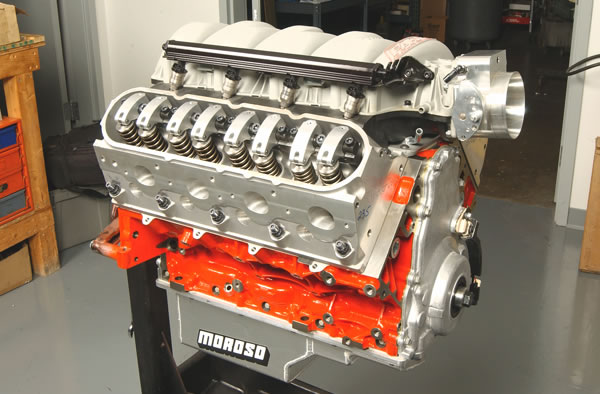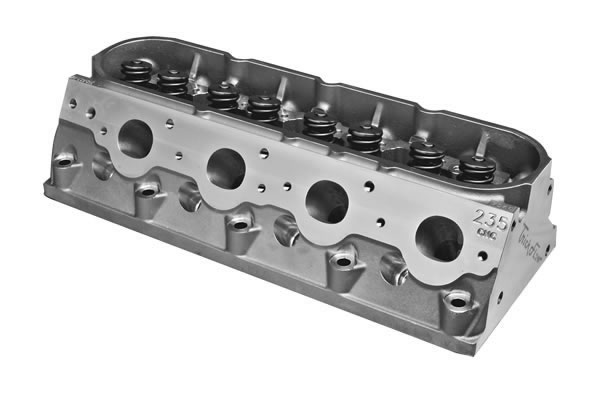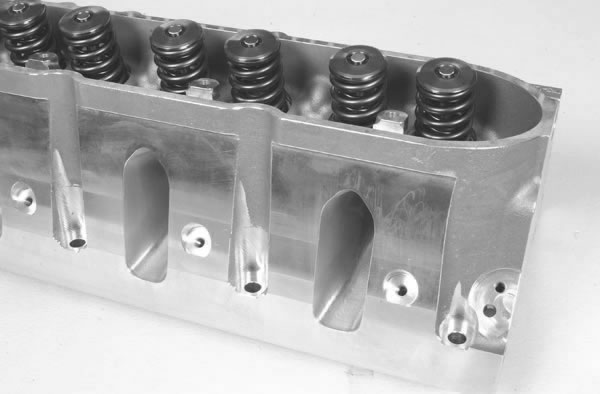When we last left you, Trick Flow Specialties was in the process of building the short block for its 440 cubic inch GM LSX engine (440 LSX, Part 1). Designed for LS development work on Trick Flow’s Superflow dyno, the short block was built heck for stout—GM Performance Parts LSX iron block, 4.125-inch stroke Lunati Pro-Series steel crank, 6.125-inch Lunati I-beam connecting rods, Diamond Racing forged pistons, and a .629-inch lift Lunati hydraulic roller cam—in preparation for a crown of CNC-machined aluminum in the form of Trick Flow’s GenX™ Street/Strip 235 cylinder heads.
As the name implies, the cylinder heads feature a 235cc intake port. But that’s only part of the story—Trick Flow engineered the Street/Strip 235s for large-bore (4.125 inches and up), big cubic inch LS motors. The 70cc combustion chambers are CNC-profiled to unshroud the intake valve for more airflow and to promote swirl for better combustion. At .600 inches of valve lift, the Street/Strip 235s flow 340 cfm on the intake side and 270 cfm on the exhaust side. Mid-lift airflow is impressive as well at 229 cfm intake/196 cfm exhaust at .300 inches of valve lift.
Heads this good deserve a quality valvetrain. The GenX Street/Strip heads come assembled with 2.08 inch intake/1.60 inch exhaust valves, 1.300 inch diameter dual valve springs, seven degree locks and lightweight titanium retainers, and Viton® seals. The heads require roller rocker arms; Trick Flow recommends using Jesel 1.7 ratio shaft roller rockers.
Induction and Ignition
The induction system revolves around a Comp Cams F.A.S.T. LSX intake manifold. The three-piece manifold is made from a special polymer that’s 30 percent stronger than the factory intake material, so it can handle a healthy shot of nitrous or blower boost. Comp added plenty of meat to the intake so you can port it to your heart’s content, and even cast in a set of bungs for nitrous oxide nozzles. Trick Flow added a 90mm Nick Williams throttle body and 44 lb.-hr. Trick Flow fuel injectors to finish off the induction system. An ACCEL DFI engine management system controls ignition and fuel.
Oiling System
A Moroso Street/Strip aluminum oil pan holds the 440’s vital fluids. The wet sump pan is designed to fit a late-model Camaro or Firebird and has a 6 quart capacity. Moroso includes a windage tray, and even welded on -10 AN fitting bungs for use with a remote-mount oil filter. A Melling standard volume oil pump and a Moroso extended oil pump pickup round out the oiling system.
How Did It Do?
A bunch of pretty parts are nice and all, but what really matters is what kind of power they make after somebody puts ’em all together. Todd Hodges and Ron Greczanik, Trick Flow’s engine builders and dyno room masters, bolted the 440 to the SuperFlow dyno. With Todd pulling the lever, the LSX delivered some serious grunt—680 peak horsepower at 6,500 rpm and 597 foot-pounds of peak torque at 5,500 rpm. Such is the awesome power when cubic inches are combined with modern hot rodding technology.
Sure, a motor like Trick Flow’s 440 LSX costs. But when you consider how easy it is to build naturally aspirated, big block-style power in a small block package—and with readily available parts to boot—an LS engine like this really is a good value. It’s ideal for use with a good nitrous kit, or fiddle with the compression ratio and you have the foundation for a killer supercharged or turbo motor (and on street gas, no less). Thanks to go-fast stuff the companies like Trick Flow make, today really is the Golden Age of Muscle.


























this is the engine that is going to go a 1976 k5 blazer with 90 chevy front end.
hahahahahaha Alex!!!! thee UPS guy juust deelivered a packagee with thee neeew ipaaadd 3 in it, after i signeed up on thaat fb event you toldd me about!!! I caant belieevee it worked,
Removee theee Spaaces —–> www. ipadtestingarchive. com
WOW!
god I want this!
I want one where do I sign Up? How much did it cost to build this motor?
I just….don’t just want…. it is issue of…I need this so bad….in my truck.. so bring it in a crate and drop it off Fed Ex….
That’s enough for me to want to pull the LT motor out of my 96 Z. I would LOVE to see that track burning tire smoker under my hood.
man this would be beast under the hood of a 1970 c/10.
now small blocks r gettin somewhere!
You can throw that under the hood of my 74 Chevy Laguna S3 anyday!
What you guys have built is a beautiful ENGINE….not a motor. The energy medium of a motor can be reused (reversible). The energy medium of an ENGINE cannot be reused (irreversible) unless you wait 50 million years for petroleum reformation. Power On !!
Is there a video of the dyno pull for this monster?
Jonathan. Unfortunately, we did not get a video. We do have some upgraded video equipment, so we hope to get more video to accompany these types of stories. Thanks for reading!
Got a 68 SS Camaro Wood Be Nice
Got 1995 GMC Sonoma sure would look good setting in it bought it new drive it every day